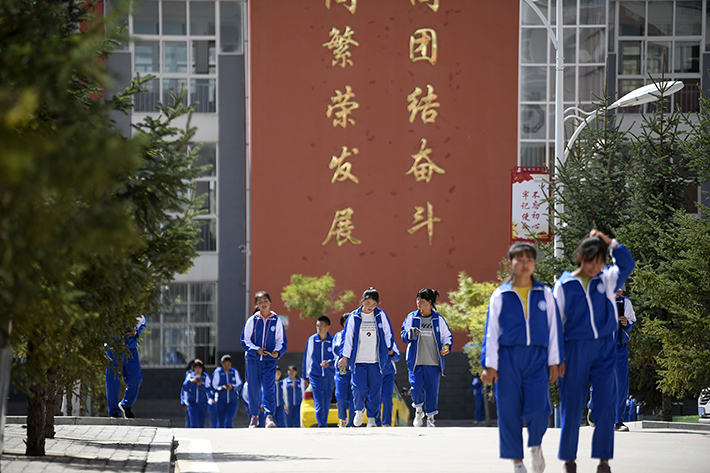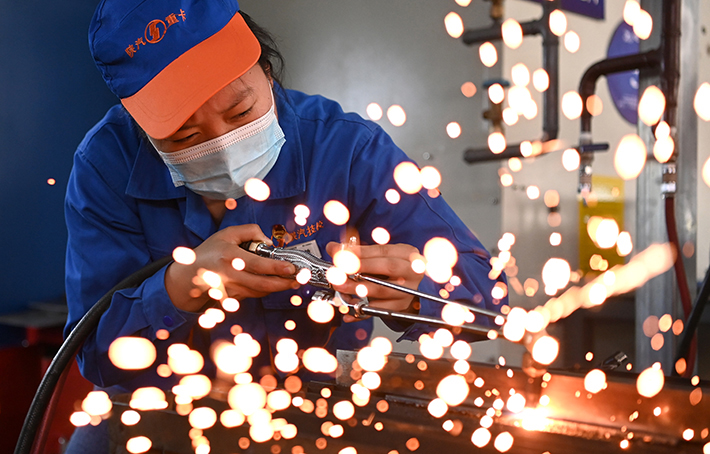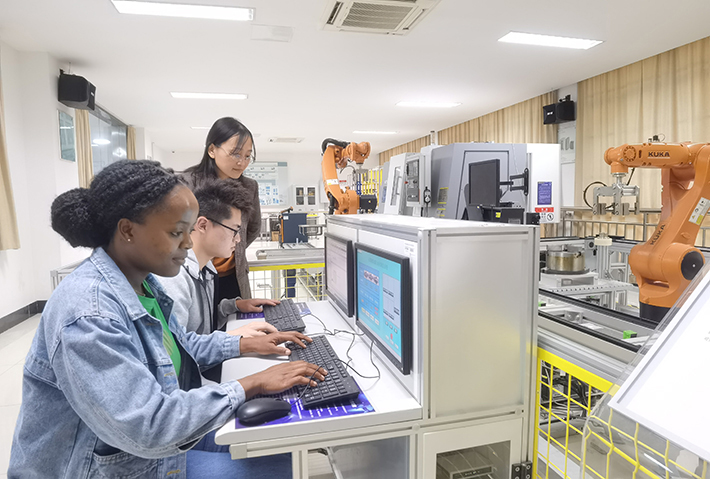|
||||||||||
| Home Nation World Business Opinion Lifestyle ChinAfrica Multimedia Columnists Documents Special Reports |
|
||||||||||
| Home Nation World Business Opinion Lifestyle ChinAfrica Multimedia Columnists Documents Special Reports |
| ChinAfrica |
| Another Way to Succeed |
| China promotes high-quality vocational education to meet the needs of industrial transformation |
| By Xia Yuanyuan 丨VOL. 15 May 2023 ·2023-04-19 |

Students walk to their classes at Xiji County Vocational High School in Ningxia Hui Autonomous Region on 16 September 2020
In China, students are enrolled into high schools, vocational institutions and universities based on their scores in entrance exams. Those who flunk in the gruelling high school entrance examination, or zhongkao, are usually admitted to vocational institutions.
That’s why Chinese parents are always worried about their children’s performance in the middle school because that determines whether they attend a regular high school or end up in a vocational programme, which is seen as “inferior.”
The deep-rooted stereotype attached to vocational education is caused by a number of factors. Many parents feel that a vocational degree equates hard work with low pay, and doesn’t lead to a bright future.
However, the situation is changing due to a high demand for skilled workers.
Data from the Ministry of Human Resources and Social Security (MOHRSS) in 2021 showed that more than 70 percent of new employees in modern manufacturing, strategic emerging industries and modern services, among other sectors, are graduates of vocational institutions. The proportion of skilled workers in China’s total workforce stood at 26 percent, and more than 50 million, or about 28 percent, of them are highly skilled.
Last May, China’s new Vocational Education Law came into effect. The amended law put the vocational education on an equal footing with general education, meaning it enjoys the same importance as general education in terms of preparing students for the job market and entrepreneurship. This is the first time the law has been revised since it was adopted in 1996.

A teacher helps students to learn about robots at the Vocational and Technical Education Centre in Jingxing County, Shijiazhuang City, Hebei Province, on 14 May
2022
‘Full of rewards’
“I’m the only one pursuing vocational education in my extended family,” said 24-year-old Li Xiaoshun, a Shanxi Province native who graduated from the GongQing Institute of Science and Technology in Jiangxi Province two years ago with a maritime diploma.
“Most of my cousins are in university or pursing postgraduate education. I felt inferior due to failing to enter a university and having to attend a vocational school,” Li told ChinAfrica. “However, I found vocational education full of rewards, and it is also a way to succeed.”
At the institute’s navigation technology and marine engineering technology training bases, Li and his classmates received high-class education. Through theoretical teaching and practical training, they gained proficiency in the skills required for sailing and maritime equipment management.
The institute has also established school-enterprise partnerships with many domestic and international shipping companies to prepare the students for employment. Last year, Li found a job at a shipping company with a monthly payment of 10,000 yuan ($1,454), much higher than the average monthly salary of 5,833 yuan ($848) for college graduates in 2021, according to data from a survey by education consultancy MyCOS.
“I think I am lucky in view of today’s conditions. We actually had hands-on practice every day at the training bases in the institute. Our teachers are experts on professional skills. I used to think that it is not easy to get a good job for vocational graduates. But the experience shows that being able to transform from ordinary to extraordinary and constantly sharpening skills are the ways to succeed,” he told ChinAfrica.
Like Li, vocational education has enabled graduates to find the field they are really passionate about, to work hard and to have the opportunity to shine. Their confidence comes from the high-quality development of China’s vocational education.
Lin Yu, deputy director general of the Department of Vocational and Adult Education, Ministry of Education (MOE), said that in 2022, secondary vocational schools enrolled 6.5 million students, accounting for 40.7 percent of the total number of junior middle school graduates. Meanwhile, higher vocational colleges enrolled 5.46 million students in 2022, with the number of students going to vocational institutions exceeding the number of those attending general four-year universities, he said.

Hu Min, an assistant teacher at Shaanxi Auto Mechanic School, performs flame cutting on 26 April 2022
Equal opportunities
Since the beginning of its reform and opening up in 1978, China has established the world’s largest vocational education system. At present, China is home to 11,300 vocational institutions, which have more than 30 million students on campuses, according to MOE.
Such a large-scale vocational education system has played an important role in cultivating talents and promoting employment and entrepreneurship in the country, according to insiders.
However, due to the ongoing industrial upgrading and economic restructuring, demand for technical and skilled personnel exceeds supply in China, which requires further expansion of vocational education, so that it can play a more prominent role in meeting the need for diversified education, and better support the country’s development.
Against this backdrop, China has amended its Vocational Education Law for the first time in 26 years. One of the most important revisions is an upgrade of the status of vocational education in China.
The newly revised law stipulates that vocational education is as important as general education, and vocational school graduates will have increased access to higher education than what was previously available.
Moreover, the revised law also stresses that vocational school students should enjoy the same opportunities as students from schools of general education in terms of employment and career development.
Chen Ziji, director general of the Department of Vocational and Adult Education of MOE, said that vocational education is not “low-level education” nor is it “education for the less able.” It is a form of education with its own distinct characteristics. “Vocational education students can choose to pursue further studies or find a job, and we will try our best to help to expand their choices for self-improvement,” he said.
Liu Hong, vice president of Yangzhou Polytechnic College, said that the revised law improves the vocational education system and makes it as important as general education, thus ensuring educational fairness.
“The revision of the law helps vocational institutions like ours to become more attractive for students, and it also provides legislative and policy support for the establishment of high-level institutions to further enhance their educational level,” he told ChinAfrica.
Industry-education integration
The revised law also encourages enterprise participation in vocational education. It promises to reward enterprises for industry-education integration and deepen cooperation with institutions.
In the 14th Five-Year Plan (2021-2025) period, China plans to increase its number of skilled workers by more than 40 million through new incentives, according to an action plan released by the MOHRSS in July 2021. However, the country’s total supply of skilled personnel still falls short of the huge demand fuelled by the country’s economic development.
Responding to changes in the economic conditions, since 2012, vocational institutions have weeded out 108 majors and added or upgraded 1,007 majors to meet the demand of China’s modern industrial system, including those that can help to upgrade the country’s industrial bases and modernise industry chains, such as Connected Vehicle technologies, the application of the Internet of Things, livestreaming e-commerce services, infant care and smart elderly care.
To further integrate vocational education into China’s economic development, the revised law encourages more enterprises to participate in vocational education, such as by establishing their own vocational institutions and setting up full-time or part-time trainee positions for vocational students. At present, 21 cities have been selected as pilot zones, and local governments have set up 4,600 businesses deeply integrated with vocational education, according to Ou Xiaoli, an official with the National Development and Reform Commission.

Portia Itumeleng Tsakane Siwele (front) conducts software programming application training in the Intelligent Manufacturing Training Room of Yangzhou Polytechnic College in Jiangsu Province on 6 April
International cooperation
Vocational education in China is also becoming attractive to foreign students.
After graduating from Tshwane South TVET College Pretoria West Campus, Pretoria, South Africa, in 2018, Portia Itumeleng Tsakane Siwele got a chance to study in Yangzhou Polytechnic College with a scholarship supported by the Chinese Culture Centre in South Africa.
During her study in Yangzhou, Siwele actively utilised the advanced vocational education facilities of the school, focusing on research in software.
Siwele said China’s vocational education resources are abundant and facilities are well-equipped. In addition to attending theoretical courses, Siwele had a chance to do internships to gain practical skills. “I feel vocational education in China enjoys same importance as general education in terms of preparing students for the job market and entrepreneurship,” Siwele told ChinAfrica.
At the end of 2022, the General Offices of the Communist Party of China Central Committee and the State Council, China’s cabinet, issued a new guideline that stressed the need for innovation in terms of international communication and cooperation. It said that China will establish a number of high-level international vocational institutions and set world-class standards for vocational majors, curricula, teaching resources and teaching equipment.
In addition, in September 2020, nine Chinese government departments, including the MOE and the MOHRSS, released the Vocational Education Quality Improvement Action Plan (2020-2023), which seeks to encourage international cooperation. For example, China has launched overseas vocational education programmes to cultivate local professional and technical personnel. One standout example is the Luban Workshop programme launched in 2016.

A student majoring in beauty and hairdressing attends practical training in the training room of Yuping Dong Autonomous County Secondary Vocational School in Tongren City, Guizhou Province, on 17 May 2022
Challenges and solutions
Despite its rapid development, vocational education is also facing certain challenges.
“Though the social recognition of vocational education is gradually increasing, it will take time to change the people’s perception and the stereotype attached to vocational education,” Liu said.
“For centuries, many Chinese believed that education was meant for training the literati and producing talents to govern the society. But education should also equip people with the ability for technical jobs. We need to change people’s mindsets, but it won’t be easy,” he said.
To eliminate students and parents’ concerns about vocational education, Su Hua, vice president of China Vocational Education Association, suggested raising the scale of vocational education to offer bachelor’s degrees, so that vocational school students could also pursue higher education and remove the hurdle of lack of an academic degree when looking for jobs.
In this way, vocational education will nurture talents with practical skills and also award degrees, and vocational school graduates will enjoy different opportunities for development and a bright future, he added.
In addition to legal provisions, funding for vocational education will also be guaranteed. According to the statistics from UNESCO, the cost of running vocational education is about three times that of general education. This is a bottleneck in the development of vocational education to a certain extent. To solve the problem, the revised law stipulates the specific work responsibilities of vocational education at different levels. Meanwhile, the funding mechanism is also being rationalised.
Chen said that the country is optimising the expenditure structure of education funds to meet the development needs of vocational education, and is encouraging institutions to raise funds through different channels in accordance with law.
|
||||||||||||
| About Us | Contact Us | Advertise with Us | Subscribe |
| Copyright Beijing Review All rights reserved 京ICP备08005356号-5 京公网安备110102005860号 |